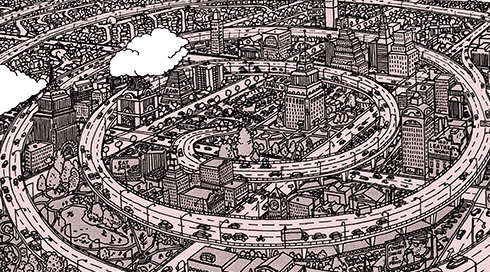
Steven M. Johnson '60
A freeway strangles the inner city (1972).
View full image

Steven M. Johnson '60
A freeway strangles the inner city (1972).
View full image
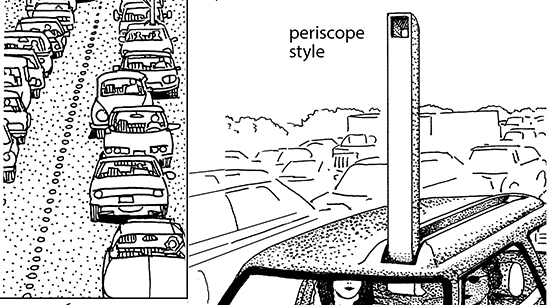
It took Johnson--a combination futurist-cartoonist with roots in urban planning-—to think up the Trafficscope in 1991. It would be extremely useful for figuring out how long the traffic jam in front of you might last.
View full image

It took Johnson--a combination futurist-cartoonist with roots in urban planning-—to think up the Trafficscope in 1991. It would be extremely useful for figuring out how long the traffic jam in front of you might last.
View full image
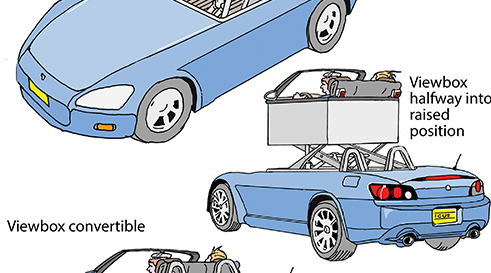
Alternatively, the Viewbox (2020) gives driver and passenger the option of keeping an eye on the traffic while enjoying the thrill of driving too fast on curving roads. The owner’s manual, Johnson specifies, would state clearly “that this is not good practice.”
View full image

Alternatively, the Viewbox (2020) gives driver and passenger the option of keeping an eye on the traffic while enjoying the thrill of driving too fast on curving roads. The owner’s manual, Johnson specifies, would state clearly “that this is not good practice.”
View full image
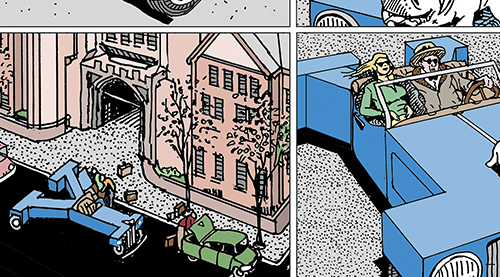
Fellow Yalies, why not impress your friends with a posh Y-Mobile (2009), which Johnson created for his Yale class reunion book? Plenty of storage space, and even a life-sized bulldog hood ornament! (Some of Johnson’s ideas have actually come to pass. This might not be one of them.)
View full image

Fellow Yalies, why not impress your friends with a posh Y-Mobile (2009), which Johnson created for his Yale class reunion book? Plenty of storage space, and even a life-sized bulldog hood ornament! (Some of Johnson’s ideas have actually come to pass. This might not be one of them.)
View full image
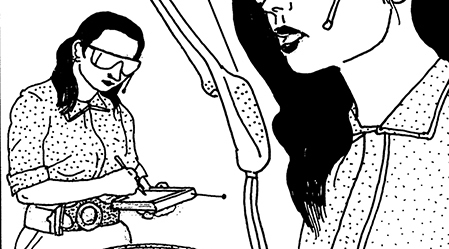
Around 1992, Johnson made this drawing of a wearable computing setup. He anticipated Google Glass with the computer screens, hidden inside a pair of glasses, that are visible to the eye of the wearer. He also imagined several other smart devices that could be carried around handily in, say, a decorative belt.
View full image

Around 1992, Johnson made this drawing of a wearable computing setup. He anticipated Google Glass with the computer screens, hidden inside a pair of glasses, that are visible to the eye of the wearer. He also imagined several other smart devices that could be carried around handily in, say, a decorative belt.
View full image
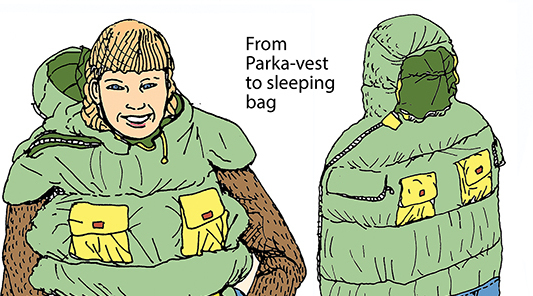
A sleeping parka-vest from 1984 means one less item to carry in cold weather! Includes instructions for converting your sleeping bag into a parka-vest and back again.
View full image

A sleeping parka-vest from 1984 means one less item to carry in cold weather! Includes instructions for converting your sleeping bag into a parka-vest and back again.
View full image
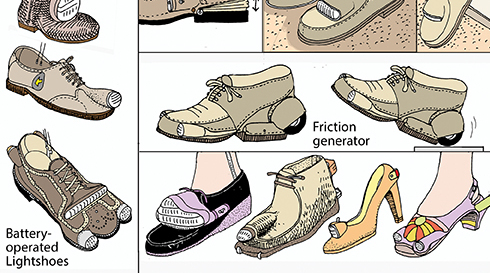
While Johnson’s 1984 Lightshoes haven’t yet caught on, Johnson is ready for when they do. A wide variety of styles in the Lightshoe category are shown here. “The purposes vary,” wrote Johnson. “Some are useful for office employees who walk along poorly lit hallways, while others are useful for nighttime snack runs at home.” Not pictured here: some variations with turn signals.
View full image

While Johnson’s 1984 Lightshoes haven’t yet caught on, Johnson is ready for when they do. A wide variety of styles in the Lightshoe category are shown here. “The purposes vary,” wrote Johnson. “Some are useful for office employees who walk along poorly lit hallways, while others are useful for nighttime snack runs at home.” Not pictured here: some variations with turn signals.
View full image
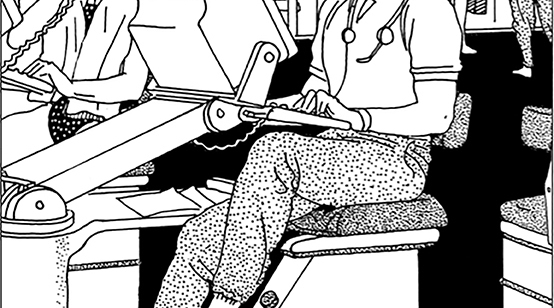
In the late ’90s, Johnson predicted fitness work stations: “Corporate support of employee fitness programs, combined with a relaxation of dress codes, leads to the health-club office ambience.”
View full image

In the late ’90s, Johnson predicted fitness work stations: “Corporate support of employee fitness programs, combined with a relaxation of dress codes, leads to the health-club office ambience.”
View full image
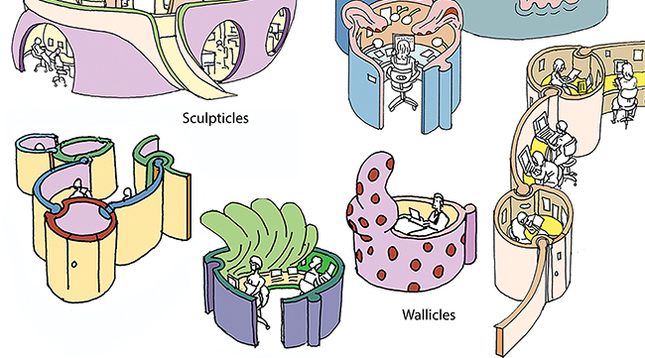
In 2010, Johnson proposed to liven up the drab, beige world of office cubicles with “ludicrous, curvaceous, extravagant cubicle shapes” to improve the office mood.
View full image

In 2010, Johnson proposed to liven up the drab, beige world of office cubicles with “ludicrous, curvaceous, extravagant cubicle shapes” to improve the office mood.
View full image
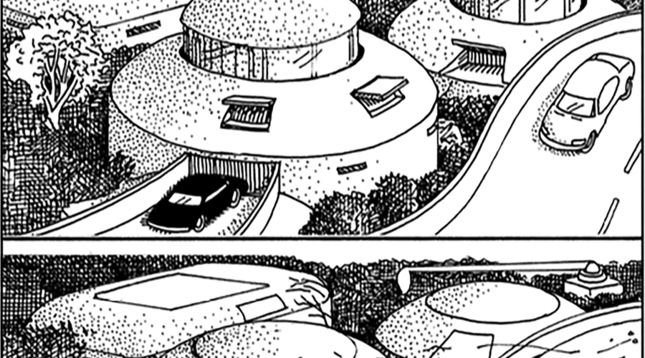
The weather-responsive buildings below are “homes that can withstand the worst possible cyclone or hurricane.” As weather worsens and pressure drops, “the second-story clerestory windows are seen to slowly sink, on pneumatic pillars, into the first floor.”
View full image

The weather-responsive buildings below are “homes that can withstand the worst possible cyclone or hurricane.” As weather worsens and pressure drops, “the second-story clerestory windows are seen to slowly sink, on pneumatic pillars, into the first floor.”
View full image
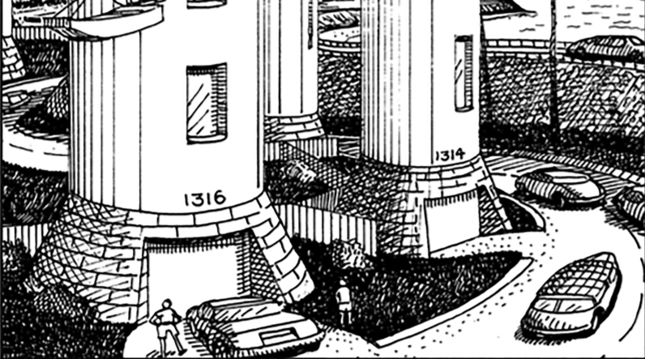
Alternatively, how about the 2010 “greenhouse-effect homes”? The inhabitants can safely contemplate rising waters from their four-story towers. And if four stories aren’t enough, the buildings are outfitted with lifeboats.
View full image

Alternatively, how about the 2010 “greenhouse-effect homes”? The inhabitants can safely contemplate rising waters from their four-story towers. And if four stories aren’t enough, the buildings are outfitted with lifeboats.
View full image

Ready for a little nap? Back in 1991, Johnson solved the problem of dozing off at work. This all-in-one office/bed setup saves space, time, and money. And although Johnson was thinking about an office, it might work just as well for those working at home in the pandemic.
View full image

Ready for a little nap? Back in 1991, Johnson solved the problem of dozing off at work. This all-in-one office/bed setup saves space, time, and money. And although Johnson was thinking about an office, it might work just as well for those working at home in the pandemic.
View full image
Inventor/artist/author/humorist/futurist Steven M. Johnson ’60 ended up getting his BA from Berkeley, but he spent his first two years at Yale with the class of 1960. During that time he took his only art class ever—with Professor Josef Albers—and English with an inspiring young teacher named Harold Bloom. The two enjoyed an email correspondence about fifty years later.
Johnson lives outside of Sacramento with Beatrice, his wife of 54 years. He has worked as a city planner, cartoonist, prognosticator at Honda, and author of several books, including Patent Depending. Although, in fact, he never did patent any inventions, he predicted quite a few that came to fruition. These include a 1991 video camera helmet—later echoed in the GoPro—and, in 1992, glasses that doubled as computer screens with a dangling microphone attached. About twenty years later Silicon Valley had the same idea: “Google Glass.” Johnson is also the genius behind the Y-Mobile, a Y-shaped car created to honor Yale.
Somehow, that one has yet to roll off the assembly line.
Q&A
Lenore Skenazy: I read that you started inventing when you were freelancing for the Sierra Club magazine?
Steven M. Johnson: In 1974, the editor asked me to think up future recreational vehicles that would kind of ruin the environment. He wanted 16. I came up with 109.
LS: Wow!
SMJ: I discovered I was a latent inventor. I was 36.
LS: In your TED Talk, you talk about mixing and matching to get fresh ideas. One mashup of yours I love is the Bike Train.
SMJ: The Pedaltrain?
LS: The train with stationary bikes instead of seats. People riding them get exercise and power the engine.
SMJ: The humor part is the most important part for me—it’ll override everything else. If it’s funny and works badly—
LS: That’s your sweet spot?
SMJ: Yes. There’s one called a Bike Vest. It’s so hugely impractical! It’s heavy, it’s awkward . . .
LS: It’s a bike you wear, and, indeed, its time has yet to come. Similarly, the airbag suit you wear in a car. And the Trojan Duck—a huge duck decoy containing hunters. Why don’t those exist?
SMJ: Culture in general favors success and forward motion, so in some ways it leaves out ideas that don’t make money.
LS: Are you making bank on these great ideas?
SMJ: There’s a part of me missing. The entrepreneurial, money-making part.
LS: Don’t you think you could get some venture capital at least for your Open Fly Alarm?
SMJ: But having an alarm go off could call attention to the fact that your fly is open.
LS: Back to the drawing board.
Read more about Johnson at his website, patentdepending.com.
 loading
loading